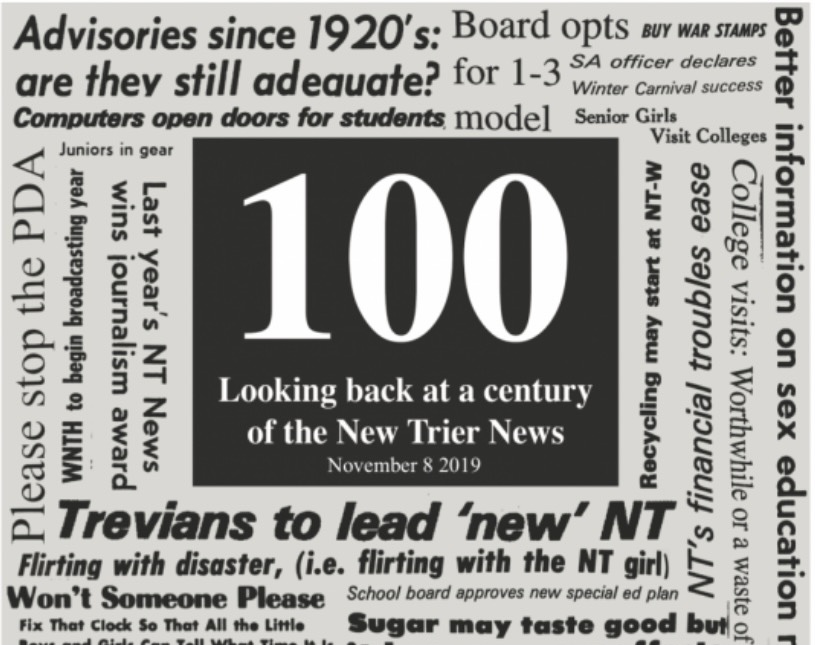Administration slaps New Trier News with cutbacks
The decision, made with co-curricular and environmental factors in mind, deprives students of a weekly newspaper
NT News File
The New Trier New’s 100 year tradition of a weekly print newspaper is being cut by administration, leaving the New Trier News to have to rely mostly on online audiences instead of being able to target students within school.
The New Trier administration has cut the print publication of The New Trier News from weekly to quarterly, arguing that it helps reduce the school’s carbon footprint and better prepares students for careers in digital journalism.
The administration is currently considering allowing the News eight printed issues over the four originally allotted, though this decision has not yet been confirmed by administrators.
As part of the decision, student publications such as LOGOS, Views, the Sophomore Journal and Calliope will no longer be printed on a regular basis.
“There were a number of considerations that went into this decision, including: reducing the environmental impact of hardcopy printing, a shift in the preferences of key stakeholder audiences and how people access information nowaday, greater ability to offer up-to-date information, and the financial impact as well,” Student Activities Director Stacy Kolack said in an email to publication sponsors on Oct. 6.
New Trier’s environmental committee, which includes students, staff, and community members, contributed to the decision to curb printing, Winnetka Campus Principal Denise Dubravec said.
“We meet multiple times a year and have discussed several times the school’s impact on the environment,” Dubravec said. “Printing 5,000 copies of the newspaper … is really coming in conflict with our environmental goals.”
Some advisers, however, suggest that the decision to curtail newspaper printing will diminish the sense of community at the school. Advisers say they will miss the traditional experience of having newspapers out for students every Friday and seeing students interacting with what their peers had to say.
“I would put the pile of newspapers on one of the front desks before kids came into advisery; almost invariably students would pick them up and it was just sort of an organic activity,” social studies teacher and adviser Robin Forrest said. “And I always found that to have a lot of value in making kids feel sort of connected to what was happening in school, or maybe some of what their peers were doing.”
The administration also says it has an obligation to ensure that journalism students are in-line with the trends of modern journalism, which has become increasingly digital.
“If you want to pursue a career in journalism, you need to be prepared in up-to-date journalism, and have a sense of focus on the online driven multimedia approach,” Dubravec said. “There’s a variety of formats, it’s not just a newspaper. Wanting to make sure that kids are looking at breaking news alerts, video, photo, and social media––all those things, being prepared for that in a curricular class is very important.”
But focusing on digital journalism without a weekly newspaper raises concerns that students will miss important news and opportunities to share their thoughts in person. The New Trier News has been a weekly print newspaper since 1919 with the exception of The Great Depression in early 1930’s. Every Friday in advisery, students would receive a copy in advisery. Now, many students don’t know the newspaper continues to exist online.
“This could mean a slow death for the newspaper,” social studies teacher Shawn Jackson said. “Reducing printing limits the audience, because the physical copy is how you get the casual audience. There are far less people that are going to make their way to the website.”
The discussion about reducing printing began in 2018, when most publications were still publishing regularly.
“We did some research looking at schools that have transitioned,” Dubravec said. “Who’s printing, how many times; that was our beginning transition to say we need to move to online.”
Some schools in the area, however, are resuming previous print publication schedules–some follow monthly schedules and others follow different, unique publication schedules. Stevenson High School, for example, continues to post online as well as distribute a printed newspaper. Schools like Glenbrook South, Loyola, and Glenbrook North are also in print and online.
Because of the pandemic, all student publications boosted their online presence last year. With the school’s subscription to School News Online (SNO), a web platform that allows publications to publish online, student writers were able to digitize their work and continue running.
That success of the online platform eventually helped administrators decide to cut printing.
“Some publications are doing great and are able to reach their audience in different, better ways,” Kolack said. “Some sponsors prefered both digital and print. We just keep continuing to improve. Our sponsors and students did an amazing job at adapting last year.”
Printing reductions extend beyond the New Trier News. Student publications and school handbooks will cease to be printed, according to Kolack.
“The guidebook, the program of study––these are no longer being printed anymore as well as student publications,” Kolack said. “These have all been digitized, including the After the Academics handbook, and are now accessible on the website.”
Although the new online platforms are working well for some publications like the Political Journal, some advisers fear that relying on one medium for news might endanger the New Trier News’ relevancy and reach to the student population.
“I understand sort of the reasoning and rationale for not wanting to make thousands of copies, but in much the same way that as a teacher I’m offering sort of digital versions and hard copies of versions who have different preferences and different sort of desires, I feel like I try to accommodate that,” Forrest said.







































